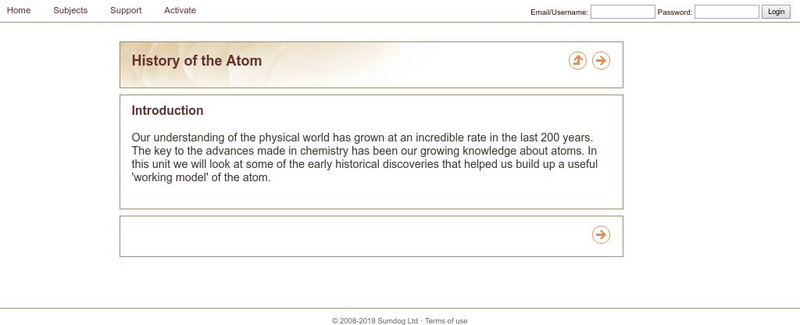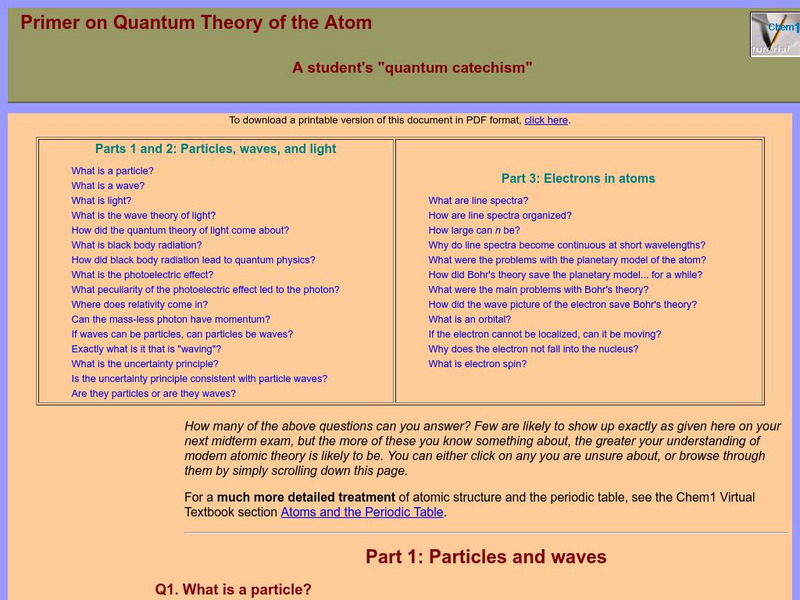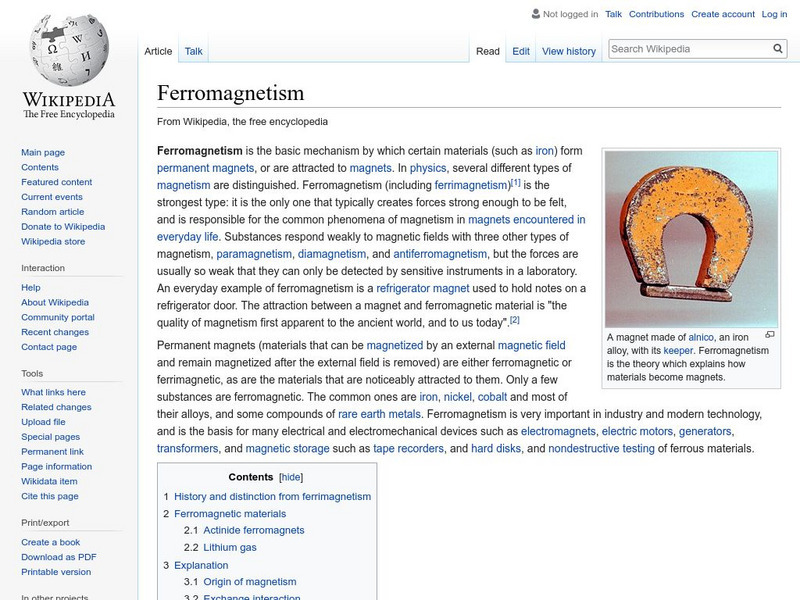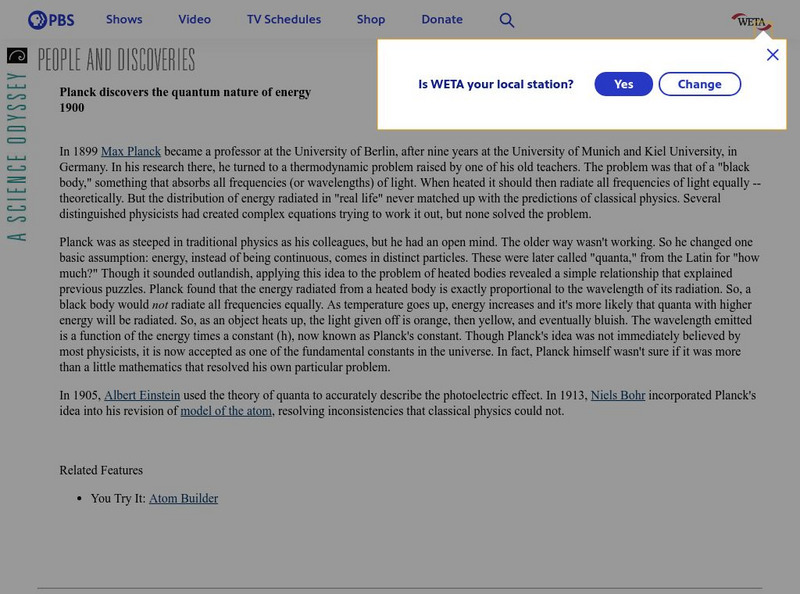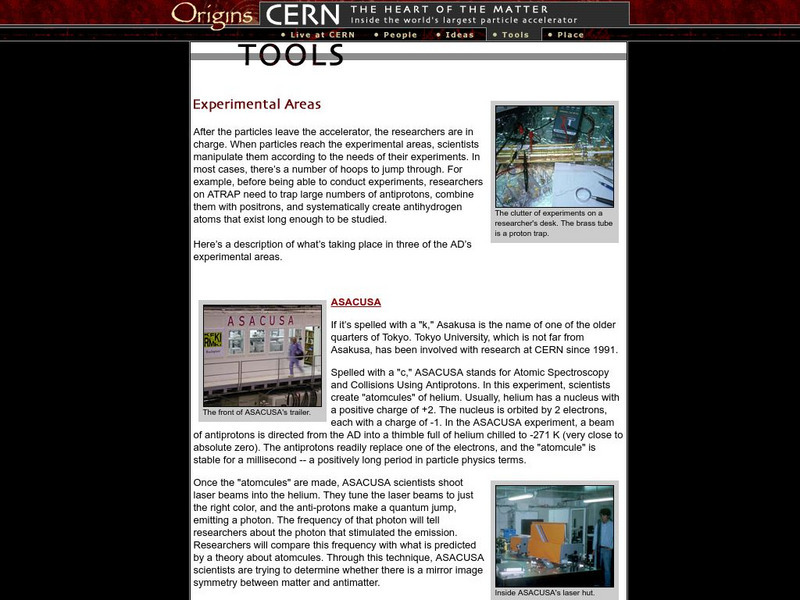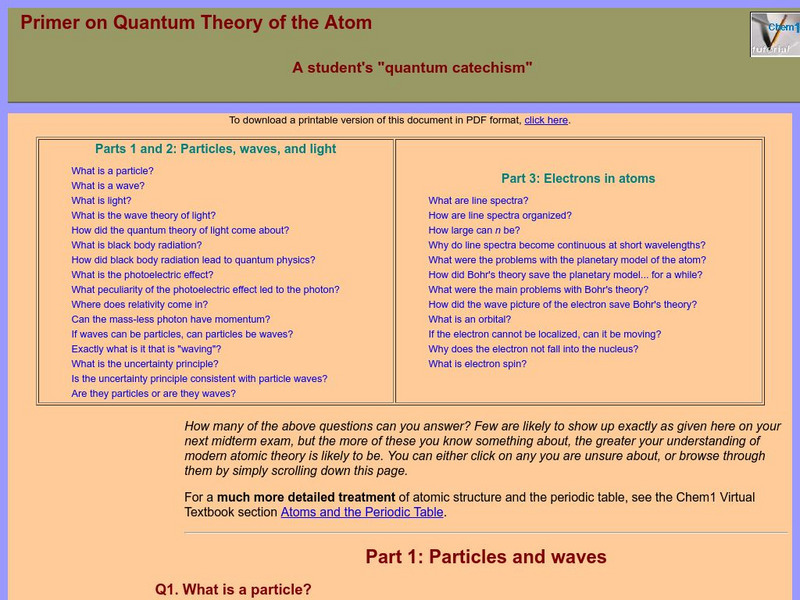Other
Crocodile Clips: Absorb Chemistry: History of the Atom
A tutorial that presents models of the atom proposed by John Dalton, J.J. Thomson, Ernest Rutherford, and Niels Bohr. Each is supported by an animated illustration. Includes comprehension questions and a quiz at the end.
Simon Fraser University
Chem1 Virtual Textbook: What Is Light?
Acting as part of an overview on quantum theory, this section of the site answers the question, what is light? In answering the question, specific discussion is directed toward light waves and theories of light.
Wikimedia
Wikipedia: Ferromagnetism
This site from Wikipedia provides a wonderful in-depth explanation of ferromagnetism, covering the atomic behavior which is responsible for ferromagnetic properties. Also introduces the concepts of magnetic domains and the Curie...
Mocomi & Anibrain Digital Technologies
Mocomi: Albert Einstein Biography
Useful biographical information, inventions, and interesting facts about German-born physicist, Albert Einstein, known for developing the theory of relativity.
Chem Tutor
Chem Tutor: States of Matter
A very descriptive site that allows students to understand the different states of matter at the atomic level. Also discusses the process of phase changes and displays phase change graphs. Thermochemistry is also touched upon for high...
PBS
Pbs: Planck Discovers the Quantum Nature of Energy
PBS offers a short summary of the discovery of the quantum nature of the atom by Max Planck. Easy to follow.
State University of New York
State University of New York: Binding Energy
This simulation allows students to understand relative binding energy.
Exploratorium
Exploratorium: Cern: The Antiproton Decelerator
Explains the function of the Antiproton Decelerator, a device at the European Center for Nuclear Research used to "slow down" bunches of antiprotons for use in experiments.
Exploratorium
Exploratorium: Cern: Experiments With Antimatter
A description of the two primary experiments conducted at CERN on antimatter: ASACUSA, an attempt to form "Atomcules," using antiprotons; and ATHENA, an experiment to compare the properties of hydrogen and antihydrogen.
Simon Fraser University
Chem1 Virtual Textbook: The Quantum Atom
Acting as a subtopic of the General Chemistry Virtual Textbook's section on Atoms and the Periodic Table, this site specifically addresses the quantum atom and related topics. The related topics include the wave function and its physical...
Simon Fraser University
Chem1 Virtual Textbook: The Shell Model of the Atom
Acting as a subtopic of the General Chemistry Virtual Textbook's section on Atoms and the Periodic Table, this site discusses the properties of the atoms individually in relation to the main group elements of the Periodic Table.
Crescent Public Schools
The Internet Science Room: Quantum Numbers
Using diagrams, illustrated examples, and student practice this chemistry class tutorial explains quantum numbers.
Math Science Nucleus
I. Science Ma Te: Integrating Science, Math and Technology
This site offers a wealth of online textbook-related materials that encourage the discovery of science in the world around us. Enter the site to access material on specific topics. Each section contains reading material (complete with...
PBS
Science Odyssey: Heisenberg States Uncertainty Principle
Explains the Heisenberg Uncertainty Principle, that it is impossible to know both the momentum and position of an electron, along with describing the impact that it made upon the scientific community upon its introduction in 1927.
Wikimedia
Wikipedia: Werner Heisenberg
In this Spanish-language entry, trace the life and accomplishments of Werner Heisenberg, the great physicist whose work with quantum mechanics resulted in earning the Nobel Prize.
Sophia Learning
Sophia: Ernest Rutherford: Lesson 2
This lesson explains Rutherford's gold foil experiment and the discovery of the nucleus. It is 2 of 3 in the series titled "Ernest Rutherford."
Famous Scientists
Famous Scientists: John Dalton
Learn about the discoveries and life of John Dalton in this article.
Famous Scientists
Famous Scientists: Wolfgang Ernst Pauli
Learn about the life and work of one of the pioneers of quantum physics, Wolfgang Ernst Pauli.
CK-12 Foundation
Ck 12: Chemistry: Democritus' Idea of the Atom
[Free Registration/Login may be required to access all resource tools.] Explains the ideas of Democritus dealing with the divisibility of the atom.
University of St. Andrews (UK)
University of St. Andrews: Max Planck
This site is a mixture of a short biography and quotes on German physicist Max Planck.
Simon Fraser University
Chem1 Virtual Textbook: What Are Line Spectra?
Acting as part of an overview on quantum theory, this section of the site answers the question, what are line spectra? In addition to the definition and a discussion of related terms, the site also discusses how line spectra are organized.
Concord Consortium
The Molecular Workbench Database: Models of the Atom's Electron Orbitals
Learn about atomic structure and the multiple theories of atomic structure in this simulation.
PBS
Pbs: People and Discoveries
At this PBS site there is a biography of the Austrian physicist Erwin Schrodinger who lived from 1887 until 1961.
Other
Sir Joseph John Thomson
Have you ever wondered who discovered the electron? The answer is Nobel Prize winning physicist Sir Joseph John Thomson.
Other popular searches
- Modern Atomic Theory
- Modern Day Atomic Theory
- Atomic Theory Time Line
- History of Atomic Theory
- Atomic Theory Worksheet
- Atomic Theory of Matter
- The Atomic Theory
- Atomic Theory Lesson Plans
- John Dalton Atomic Theory
- Progression of Atomic Theory
- Dalton's Atomic Theory
- Atomic Theory Timeline


